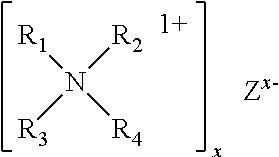Accelerated cure of isocyanate terminated prepolymers
a technology of isocyanate and prepolymer, applied in the field of polyurethane elastomers, can solve the problems of cracked surface, uneven structure of resultant polyurethane elastomers, and productivity decline, and achieve the effect of increasing productivity and speeding up the cure rate of the reaction mixture of prepolymer/chain extender
- Summary
- Abstract
- Description
- Claims
- Application Information
AI Technical Summary
Benefits of technology
Problems solved by technology
Method used
Image
Examples
example 1
Preparation of Various Prepolymer Mixtures
[0070]To determine cure rate of a prepolymer mixture / chain extender combination, various prepolymer mixtures were prepared. Table 1 shows the prepolymer mixtures of Examples 1A-1H, which were prepared using Adiprene® LFM 500 as the isocyanate terminated prepolymer. To the Adiprene® LFM 500, 1.0 pph of various organic salts were added.
[0071]
TABLE 1Prepolymer MixturesIsocyanateExam-TerminatedpleOrganic salt, 1.0 phrDescriptionPrepolymer1AControl—Adiprene ® LFM 5001BVariquat CC-42 NSQuaternary Adiprene ® LFM 500Ammonium Chloride1CLecithinPhospholipidAdiprene ® LFM 5001DVariquat CC-9 NSQuaternary Adiprene ® LFM 500Ammonium Chloride1EVariquat CC-59Quaternary Adiprene ® LFM 500Ammonium Phosphate1FVariquat 56Imidazolinum Adiprene ® LFM 500sulfate1GTegopren 6924Diorganic salt Adiprene ® LFM 500Polydimethyl Siloxane1HVarisoft 3696Imidazolinum Adiprene ® LFM 500sulfate
[0072]The prepolymer mixtures of TABLE 1 were heated to 50° C. A chain extender, 44%...
example 2
[0075]Additional samples utilizing polyether-based isocyanate terminated prepolymers were prepared in the same manner as Example 1, but using different isocyanate terminated prepolymers. TABLE 3 shows the components of Examples 2A-2H.
[0076]
TABLE 3Prepolymer MixturesIsocyanateExam-TerminatedpleOrganic salt, 1.0 phrDescriptionPrepolymer2AControl—Adiprene ® LF 950A2BVariquat CC-42 NSQuaternary Adiprene ® LF 950AAmmoniumChloride2CControl—Adiprene ® L3002DVariquat CC-42 NSQuaternary Adiprene ® L300AmmoniumChloride2EControl—Adiprene ® LFP 950A2FVariquat CC-42 NSQuaternary Adiprene ® LFP 950AAmmoniumChloride2GControl—Adiprene ® LFH 5202HVariquat CC-42 NSQuaternary Adiprene ® LFH 520AmmoniumChloride
[0077]The prepolymer mixtures of TABLE 3 were heated to 50° C. 44% methylenedianiline sodium chloride coordination complex dispersed in dioctyl adipate, was added with mixing. The resultant reaction mixture was poured into a hardness cup and placed in a temperature controlled forced convection ov...
example 3
[0080]Additional samples utilizing MDI-polyester-based isocyanate terminated prepolymers were prepared in the same manner as Example 1, but using different isocyanate terminated prepolymers. TABLE 5 shows the components of Examples 3A-3H.
[0081]
TABLE 5Prepolymer MixturesIsocyanate Exam-Organic salt, Terminatedple1.0 phrDescriptionPrepolymer3AControl—S850 ***3BVariquat Quaternary S850CC-42 NSAmmoniumChloride3CControl—S9003DVariquat Quaternary S900CC-42 NSAmmoniumChloride3EControl—Adiprene ® LFM 1451****3FVariquat Quaternary Adiprene ® LFM 1451CC-42 NSAmmoniumChloride3GControl—Adiprene ® LFM 13003HVariquat Quaternary Adiprene ® LFM 1300CC-42 NSAmmoniumChloride*** S850 and S900 arc MDI terminated PBHAG prepolymers (copolymer of butanediol, hexanediol, and adipic acid.****LFM 1300 is an MDI terminated PEAG prepolymer (polymer of adipic acid and ethylene glycol).
[0082]The prepolymer mixtures of TABLE 5 were heated to 70° C. 44% methylenedianiline sodium chloride coordination complex dispe...
PUM
| Property | Measurement | Unit |
|---|---|---|
| weight percent | aaaaa | aaaaa |
| Brookfield viscosity | aaaaa | aaaaa |
| temperature | aaaaa | aaaaa |
Abstract
Description
Claims
Application Information
 Login to View More
Login to View More - R&D
- Intellectual Property
- Life Sciences
- Materials
- Tech Scout
- Unparalleled Data Quality
- Higher Quality Content
- 60% Fewer Hallucinations
Browse by: Latest US Patents, China's latest patents, Technical Efficacy Thesaurus, Application Domain, Technology Topic, Popular Technical Reports.
© 2025 PatSnap. All rights reserved.Legal|Privacy policy|Modern Slavery Act Transparency Statement|Sitemap|About US| Contact US: help@patsnap.com


